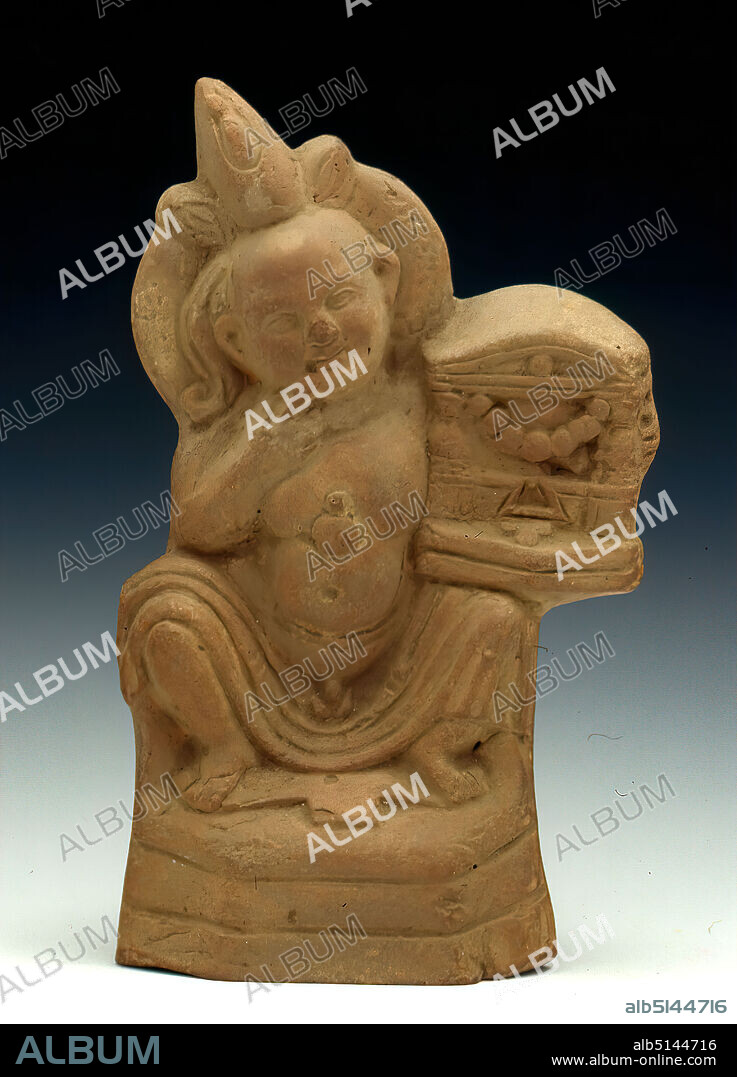alb5144716
Harpocrates with temple shrine, clay, pressed into the form, hand-modeled, fired (ceramic), clay, Total: Height: 14.4 cm; Width: 9.4 cm; Depth: 5 cm, Pottery, Egyptian gods, demigods, heroes, Harpocrates, seated figure, Early Imperial period, Middle Imperial period, Late Imperial period, The childlike, corpulent harpocrates with youth curl is enthroned on a profiled hexagonal base with a blanket With his left hand he holds a small temple shrine placed on his knee. He has led his right index finger to his mouth in a gesture typical of the god. He is naked except for a cloth laid over his thighs, which leaves his thick belly and penis free. On his chest lies a so-called heart amulet. The skull is decorated with a wreath and the double crown flanked by two buds. Harpocrates, Horus as a child, is the most favored figure among the Greco-Roman terracottas besides the goddess Isis. The depictions have undergone a thorough Hellenization, whereby native Egyptian features are always connected with Greek ones. The shaven head with horus curl is Egyptian. The temple shrine is - as the comparisons show - quite rare. The figure belongs to the group of the so-called Fayum terracottas. In Alexandria, the international, Greek-influenced center of Egypt, lived a multicultural society of Egyptians, Orientals, Greeks, Romans, Jews and others, whose different religious ideas gradually merged. Insights into this world of faith are provided by the so-called Fayum terracottas. They are part of the religious household, children's toys, knick-knacks, but also cult symbols, grave goods, pilgrimage images, votive offerings and magical objects for banishing evil forces. They can be found in houses, graves and sanctuaries.

|
Add to another lightbox |
|
Add to another lightbox |



Caption:
Harpocrates with temple shrine, clay, pressed into the form, hand-modeled, fired (ceramic), clay, Total: Height: 14.4 cm; Width: 9.4 cm; Depth: 5 cm, Pottery, Egyptian gods, demigods, heroes, Harpocrates, seated figure, Early Imperial period, Middle Imperial period, Late Imperial period, The childlike, corpulent harpocrates with youth curl is enthroned on a profiled hexagonal base with a blanket With his left hand he holds a small temple shrine placed on his knee. He has led his right index finger to his mouth in a gesture typical of the god. He is naked except for a cloth laid over his thighs, which leaves his thick belly and penis free. On his chest lies a so-called heart amulet. The skull is decorated with a wreath and the double crown flanked by two buds. Harpocrates, Horus as a child, is the most favored figure among the Greco-Roman terracottas besides the goddess Isis. The depictions have undergone a thorough Hellenization, whereby native Egyptian features are always connected with Greek ones. The shaven head with horus curl is Egyptian. The temple shrine is - as the comparisons show - quite rare. The figure belongs to the group of the so-called Fayum terracottas. In Alexandria, the international, Greek-influenced center of Egypt, lived a multicultural society of Egyptians, Orientals, Greeks, Romans, Jews and others, whose different religious ideas gradually merged. Insights into this world of faith are provided by the so-called Fayum terracottas. They are part of the religious household, children's toys, knick-knacks, but also cult symbols, grave goods, pilgrimage images, votive offerings and magical objects for banishing evil forces. They can be found in houses, graves and sanctuaries.
Personalities:
Credit:
Album / quintlox
Releases:
Model: No - Property: No
Rights questions?
Rights questions?
Image size:
3110 x 4320 px | 38.4 MB
Print size:
26.3 x 36.6 cm | 10.4 x 14.4 in (300 dpi)
Keywords:
ALEXANDRIA • ANATOMY: SKULL • BANISHING EVIL FORCES • BELIEF • BLANKET • CERAMIC • CERAMICS • CHEST LIES • CHILD • CHILDLIKE • CHILDREN'S TOYS • CLAY • CLOTH LAID • COMFORTER (COVERS) • COMPARISONS • CONNECTED • CORPULENT HARPOCRATES • CRANEO • CRANEOS • CRANIUM • CRANIUMS • CULT SYMBOLS • DECOR • DECORATED • DECORATION • DECORATIONS • DECORATIVE • DEMIGODS • DEPICTIONS • DEPTH • DIFFERENT RELIGIOUS IDEAS GRADUALLY MERGED • DOUBLE CROWN FLANKED • DUVET • EARLY IMPERIAL PERIOD • EGYPT • EGYPTIAN GOD • EGYPTIAN GODDESS ISIS • EGYPTIAN • EGYPTIANS • ENTHRONED • FAITH • FAVORED FIGURE • FAYUM TERRACOTTAS • FIGURE BELONGS • FIRED • FORM • GESTURE TYPICAL • GOD • GODDESS ISIS • GRAVE GOODS • GRAVES • GRECO-ROMAN TERRACOTTAS BESIDES • GREEK ONES • GREEK-INFLUENCED CENTER • GREEKS • GROUP • HAND-MODELED • HARPOCRATES • HEART AMULET • HEROES • HOLDS • HORUS CURL • HORUS • HOUSE • HOUSES • INSIGHTS • INTERNATIONAL • ISIS • ISIS, GODDESS • JEW • JEWISH • KERAMEIKOS • KNEE • LATE IMPERIAL PERIOD • LEAVES • LED • LEFT HAND • LIVED • MAGICAL OBJECTS • MIDDLE IMPERIAL PERIOD • MOUTH • MULTICULTURAL SOCIETY • NAKED EXCEPT • ORIENTALS • ORNAMENT • ORNAMENTATION • ORNAMENTS • PART • PENIS FREE • PILGRIMAGE IMAGES • POTTERIES • POTTERY • PRESSED • PROFILED HEXAGONAL BASE • PROVIDED • QUILT • QUITE RARE • RELIGION • RELIGIOUS HOUSEHOLD • RELIGIOUS • RIGHT INDEX FINGER • ROMANS • SANCTUARIES • SEATED FIGURE • SHAVEN HEAD • SKULL • SKULL, ANATOMY • SKULLS • SMALL TEMPLE SHRINE PLACED • STONEWARE • TEMPLE SHRINE • TERRA COTTA • TERRACOTA • TERRACOTTA • THE • THICK BELLY • THIGHS • THOROUGH HELLENIZATION • TWO BUDS • UNDERGONE • VOTIVE OFFERINGS • WHEREBY NATIVE EGYPTIAN FEATURES • WORLD • WREATH • YOUTH CURL
 Pinterest
Pinterest Twitter
Twitter Facebook
Facebook Copy link
Copy link Email
Email

